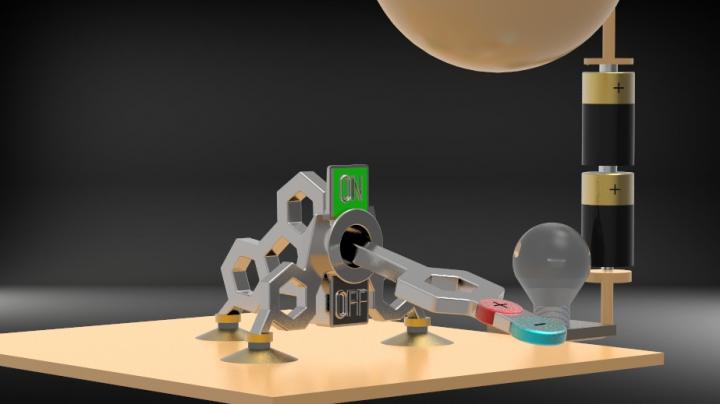Reliable molecular toggle switch developed

The molecular contact can be switched on and off mechanically and electrostatically. (Photo: KIT)
Nanotechnology constantly allows for new records in miniaturization. Reduction of the dimension of electronic components, however, has physical limits that will be reached soon. Novel materials and components are required. This is where molecular electronics comes in. Scientists of Karlsruhe Institute of Technology (KIT) have now succeeded in developing a molecular toggle switch that does not only remain in the position selected, but can also be flipped as often as desired. This is reported in Nature Communications.
“By replacing conventional silicon-based components, e.g. a switch, by individual molecules, future electronic circuits might be integrated on a space smaller by a factor of 100,” Lukas Gerhard of KIT's Institute of Nanotechnology says.
The basic structure of the electromechanical switch consists of a few carbon atoms. Three sulfur atoms form the feet that are fixed to a smooth gold surface. The toggle lever ends in a nitrile group with a nitrogen atom. It is flipped when voltage is applied. The resulting electric field exerts a force on the charge of the nitrogen atom. In this way, contact to a second electrode (here, the gold tip of a scanning tunneling microscope) is established.
The complete switch measures not more than a nanometer. For comparison: The smallest structures used in semiconductor technology are 10 nm in dimension. “Molecular electronics, hence, would be big progress,” Gerhard says.
It is not only the size of the switch that is remarkable, but the fact that it works reliably and foreseeably. This means that its operation always leads to a switching state. The contact is either open or closed. So far, implementation of this principle has often failed due to insufficient controllability of electric contacting of individual molecules. For the first time, KIT researchers have now succeeded in opening and closing such a contact between a molecule and a gold tip electrically and mechanically as often as desired, without plastic deformation being caused.
In the opinion of Gerhard, progress in synthetic chemistry has resulted in the possibility of making available a large variety of billions of molecular building blocks of identical atomic design. “Their interconnection, however, requires them to be touched without being damaged.” Such a gentle method has now be found and Gerhard considers this to be the decisive novelty.
###
This publication is the result of close cooperation between experimental physicists and chemists of KIT's Institute of Nanotechnology and of the University of Basel and theoretical physicists of the University of Konstanz.
Karlsruhe Institute of Technology (KIT) pools its three core tasks of research, higher education, and innovation in a mission. With about 9,300 employees and 25,000 students, KIT is one of the big institutions of research and higher education in natural sciences and engineering in Europe.
KIT – The Research University in the Helmholtz Association
Media Contact
All latest news from the category: Materials Sciences
Materials management deals with the research, development, manufacturing and processing of raw and industrial materials. Key aspects here are biological and medical issues, which play an increasingly important role in this field.
innovations-report offers in-depth articles related to the development and application of materials and the structure and properties of new materials.
Newest articles

Bringing bio-inspired robots to life
Nebraska researcher Eric Markvicka gets NSF CAREER Award to pursue manufacture of novel materials for soft robotics and stretchable electronics. Engineers are increasingly eager to develop robots that mimic the…

Bella moths use poison to attract mates
Scientists are closer to finding out how. Pyrrolizidine alkaloids are as bitter and toxic as they are hard to pronounce. They’re produced by several different types of plants and are…

AI tool creates ‘synthetic’ images of cells
…for enhanced microscopy analysis. Observing individual cells through microscopes can reveal a range of important cell biological phenomena that frequently play a role in human diseases, but the process of…





















